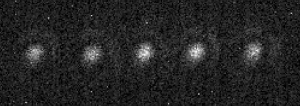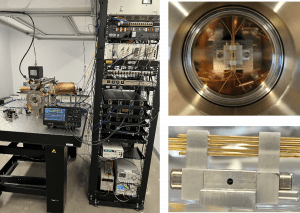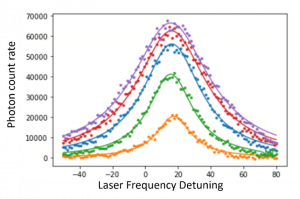The Oregon ions group is now officially an ion trap group. Earlier this month we successfully trapped 40Ca+ ions!

Five 40Ca+ ions loaded into our linear Paul trap. The ions are spaced about 5 microns apart.
We trap ions by first ionizing neutral Calcium via a two-photon process that strips a single valence electron from the selected isotope of Calcium. We select the isotope by tuning our laser near resonance of isotope we want to load. The neutral atoms come from a thermal oven, which produces a atomic beam that intersects with our photo-ionization lasers at the center of the trap. At its center, the trap is deeper than the initial kinetic energy of the ions.
 Spectroscopy of neutral calcium showing the different isotopes present in our sample. We selectively
Spectroscopy of neutral calcium showing the different isotopes present in our sample. We selectively
load an isotope by tuning our lasers near the resonance of a that isotope.
We form a Coulomb crystal by cooling the ions using a laser beam tuned below the resonance of the relatively broad S1/2 – P1/2 transition in Calcium. This process is called Doppler cooling and as we scatter tens of millions of photons a second, we quickly cool the ions down to the millikelvin level where a crystal forms.
The ions are trapped using a combination of static and radio frequency electric fields, called a linear Paul trap. In two dimensions the ions are confined by an oscillating quadrupole field that generates an effective 2-dimensional harmonic potential. In the third dimension, we use static potential on the end caps of the trap.
 The vacuum chamber that houses our linear Paul trap sits on an optical table with optics to direct the lasers into the trap. We have built a gold-plated rod trap that uses DC and RF electric fields to trap ions. Electronic control hardware in the rack on the right allows for precise timing of laser pulses.
The vacuum chamber that houses our linear Paul trap sits on an optical table with optics to direct the lasers into the trap. We have built a gold-plated rod trap that uses DC and RF electric fields to trap ions. Electronic control hardware in the rack on the right allows for precise timing of laser pulses.
Now that we can load ions into our trap, we have begun a series of experiments to characterize our trap and ensure everything is working correctly. We have performed spectroscopy of the S1/2 – P1/2 transition. We have also ‘tickled’ our ions by modulating the potential on our compensation field electrodes to determine the frequency our ions oscillate at.
 Frequency scans of our laser over the S1/2 – P1/2 in 40Ca+ at different intensities. As the laser power is increased, we broaden the transition and see fluorescence at larger detuning.
Frequency scans of our laser over the S1/2 – P1/2 in 40Ca+ at different intensities. As the laser power is increased, we broaden the transition and see fluorescence at larger detuning.
We are continuing to develop our experimental code to run more tests on our setup and are currently setting up new beam lines to perform our first experiments using qubits.